Ever wondered if you can layer polyurethane over linseed oil to beautify and protect your wood? Discover the ins and outs, and unveil the secret to a lasting, lustrous finish! Are you ready to transform your wooden treasures? Read on!
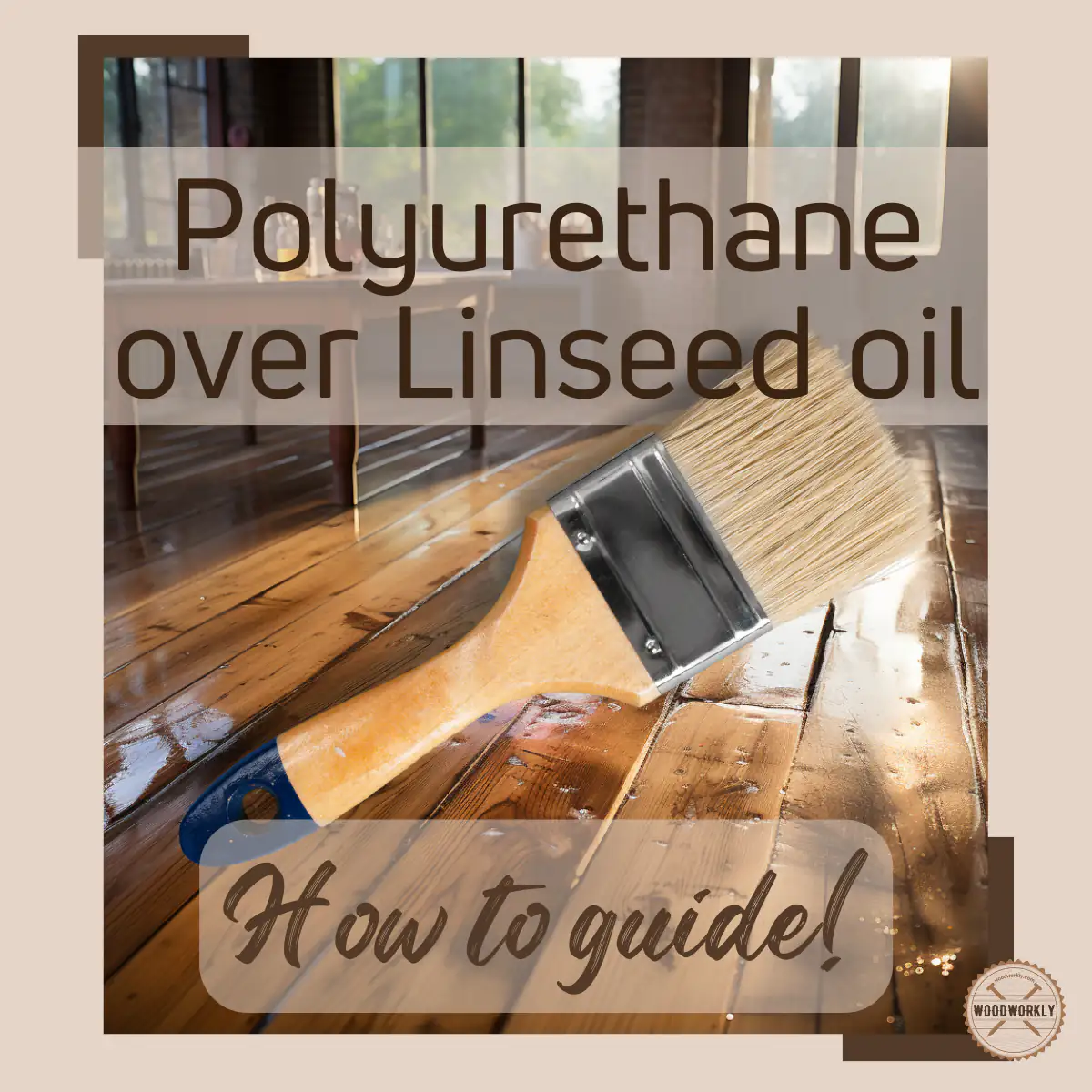
Have you ever wondered if it’s possible to maintain the traditional beauty of wood treated with linseed oil while also enjoying the durability of a polyurethane finish in your woodworking projects?
This is a question I often get asked. Today, I’ll share my experience and expert advice on this topic.
Yes, it is indeed possible to achieve both the aesthetic appeal of linseed oil and the long-lasting durability of polyurethane in woodworking!
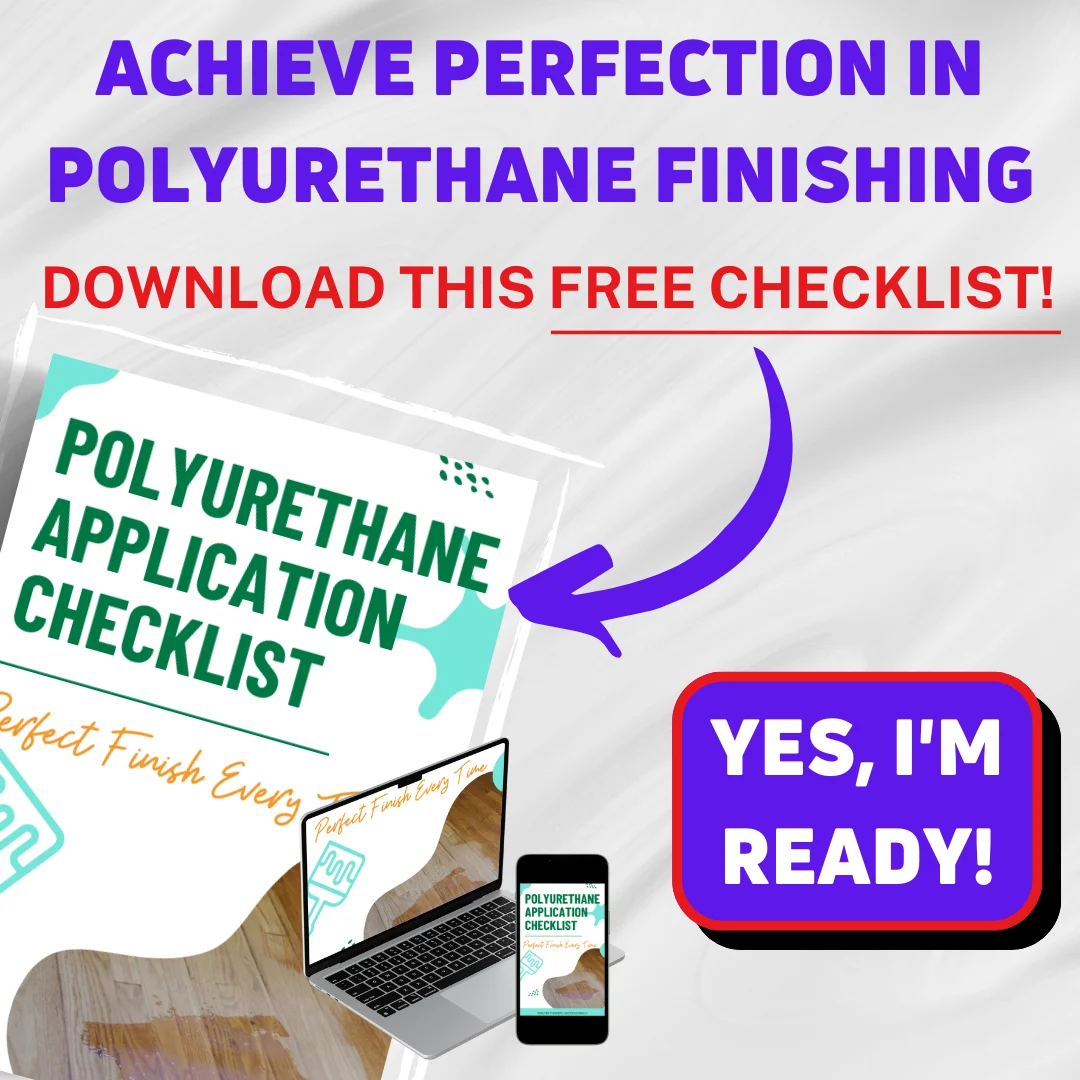
Now the question may arise as to whether you can put polyurethane over linseed oil?
Yes, you can apply polyurethane over linseed oil. Ensure the linseed oil is fully cured, and the surface is clean and sanded for optimal adhesion. Oil-based polyurethane is typically preferred for its compatibility with linseed oil.
Don’t think that you are now well informed about this; actually, there are many things you need to know about putting polyurethane on this linseed oil.
So, in this article, I will bring you the factors you should consider when applying polyurethane over linseed oil, how to do it and much more.
So, let’s explore the world of woodworking finishes and take a journey to master the art of applying polyurethane over linseed oil.
Let’s get right to it!

Can You Put Polyurethane Over Linseed Oil?
Yes, you can put polyurethane over linseed oil.
Do you know? Linseed oil is a traditional wood finish that enhances the wood’s natural beauty and provides some level of protection, but it takes longer to finish looking good.
However, before doing this, one thing you should pay attention to is to make sure that the linseed oil has completely dried and cured.
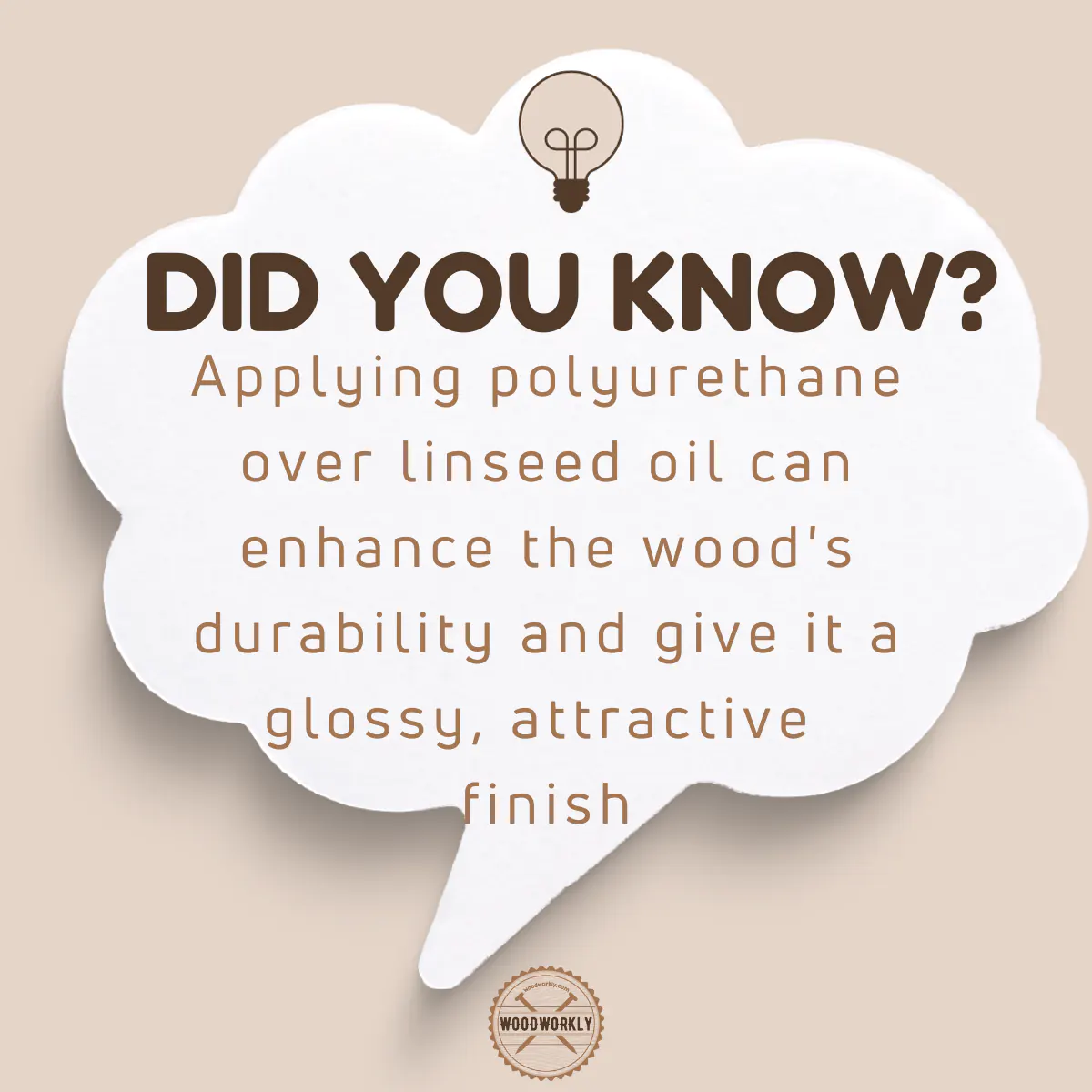
In particular, it is important to remember that depending on the environmental conditions, linseed oil can take several weeks or months to completely dry.
You can prepare the surface properly, including sanding and cleaning, to ensure good adhesion between the linseed oil and the polyurethane.
Also, compatibility between specific linseed oil and polyurethane products should be considered, as some combinations may not work well together.
I advise you to test on a small, inconspicuous area before applying polyurethane over linseed oil.

Can You Put Polyurethane Over Boiled Linseed Oil?
Yes, polyurethane can be applied over boiled linseed oil, but there are a few things you need to understand here.
Now you may be thinking, what will happen by adding a layer of polyurethane to the top?
If you want to add a layer of polyurethane to the top, first let the linseed oil dry thoroughly.
Keep in mind that this can take weeks or months to dry depending on weather conditions.
In addition, you must ensure that the linseed oil does not form a film on the surface; otherwise, the polyurethane will not adhere properly.
A few simple things I take care of when applying polyurethane over boiled linseed oil are sanding and cleaning for proper surface preparation and good adhesion.

Can You Put Oil-Based Polyurethane Over Boiled Linseed Oil?
Yes, you can apply oil-based polyurethane over boiled linseed oil.
But the main thing to pay attention to is to make sure that the boiled linseed oil has completely dried and formed a stable surface before applying the polyurethane.
As mentioned earlier, surface preparation such as sanding and cleaning is very important for good adhesion.
In addition, it is possible to ensure that oil-based polyurethane and boiled linseed oil are compatible, especially by checking the manufacturer’s recommendations and conducting a small test in an inconspicuous area.

Can You Put Water-Based Polyurethane Over Boiled Linseed Oil?
Yes, while applying water-based polyurethane over boiled linseed oil is usually possible, it can be more challenging compared to using oil-based polyurethane.
That’s because water-based polyurethanes are harder to adhere to than oil-based finishes. Therefore, it is essential to thoroughly prepare the surface, including sanding and cleaning.
In addition, it is very important to ensure that the boiled linseed oil is completely cured and to verify the compatibility between the products by checking or consulting the manufacturer’s guidelines.
Water-based polyurethane can raise wood grain, so do additional sanding between coats to achieve a smooth finish.

Factors You Need to Consider When Putting Polyurethane Over Linseed Oil
Now you may be wondering if there are factors you should consider when putting polyurethane over linseed oil.
Of course, yes I have listed below some of the main factors I consider when putting polyurethane over linseed oil.
1. Surface Preparation
One thing that you should definitely pay attention to is preparing the wooden surface properly.
Here you can sand the surface to create a smooth and uniform texture.
To ensure good adhesion between the linseed oil and the polyurethane, you can remove any dust or debris and clean the wood thoroughly.
2. Linseed Oil Drying Time
Now you know that linseed oil takes considerable time to dry.
So, before applying polyurethane, make sure that the linseed oil is completely dried and cured.
Keep in mind that applying polyurethane over uncured linseed oil can cause adhesion problems and an intermediate finish, as this can take weeks to months, especially depending on environmental conditions.

3. Method of Application
Another thing you should pay attention to is applying polyurethane in thin, even coats. Avoid applying it too thickly.
Otherwise this can lead to drips and an uneven finish. I would also advise you to follow the manufacturer’s instructions regarding drying time between coats.
4. Sanding Between Coats
Depending on the wood and finish, you should definitely sand lightly between coats of polyurethane if you want a smooth and flawless finish.
This sanding process helps you remove imperfections in the finish and ensures better adhesion for subsequent coatings.
5. Compatibility
Did you know that not all linseed oil and polyurethane products are compatible?
Therefore, before proceeding with the full application, check the manufacturer’s recommendations and conduct a small compliance test in an inconspicuous area.
That way you can easily avoid mixing incompatible products, such as peeling or bubbling.
6. Type of Polyurethane
Consider whether you are using oil-based or water-based polyurethane.
While oil-based polyurethanes generally adhere better than linseed oil, water-based polyurethanes may require surface preparation and careful inspection due to potential adhesion problems.
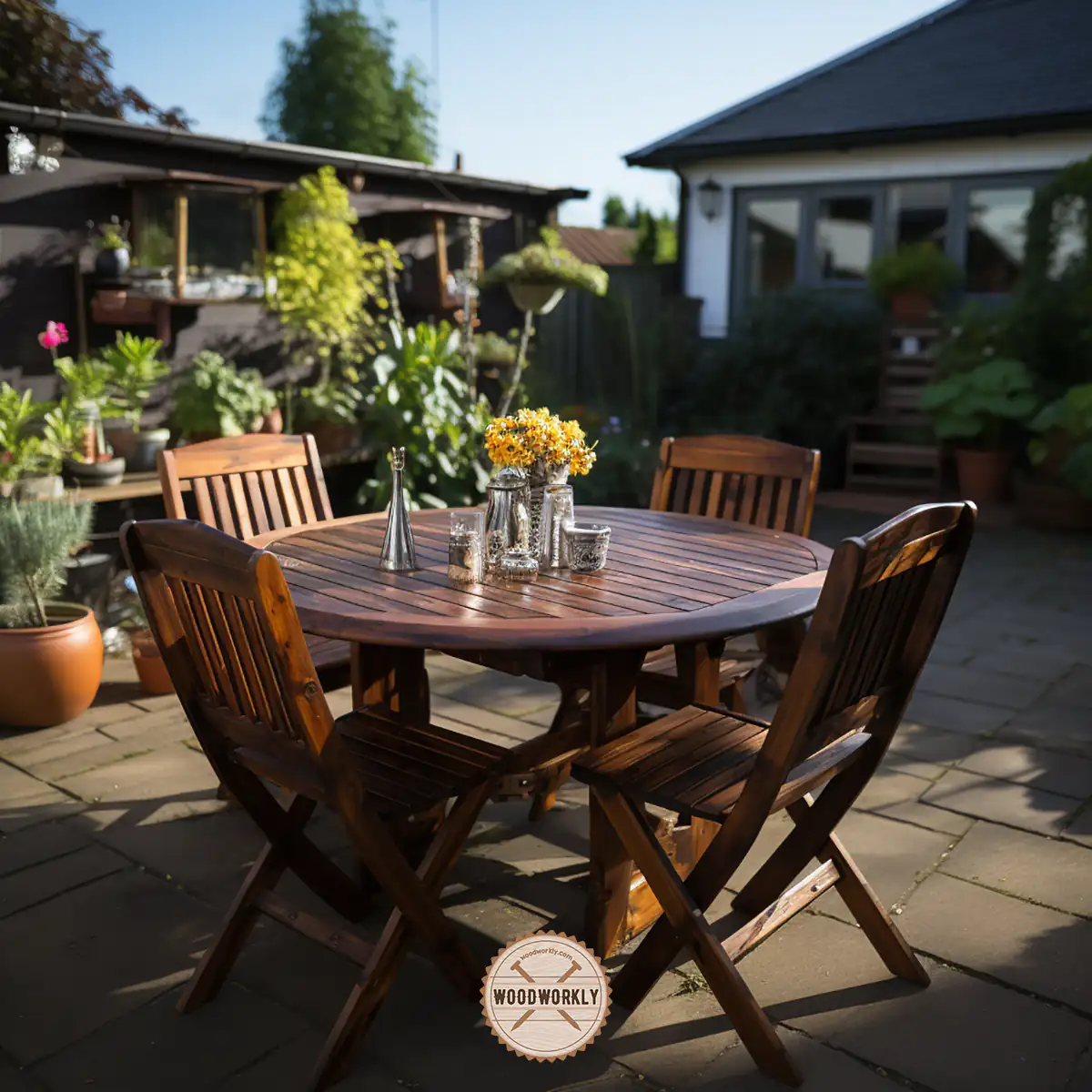
7. Environmental Conditions
You may be looking at how environmental conditions can affect your finish right now, in fact, the temperature and humidity of your working environment can affect the drying and curing times of both linseed oil and polyurethane.
So take care of these factors to get the best results for you.
8. Safety Gear
When working with linseed oil and polyurethane, these products release fumes that can be harmful.
Therefore I strongly advise you to use appropriate safety gear including gloves, eye protection, and adequate ventilation in your work area.
By carefully considering these factors and following best practices, you can successfully apply polyurethane over linseed oil.
Additionally, you get a durable and attractive wood finish.
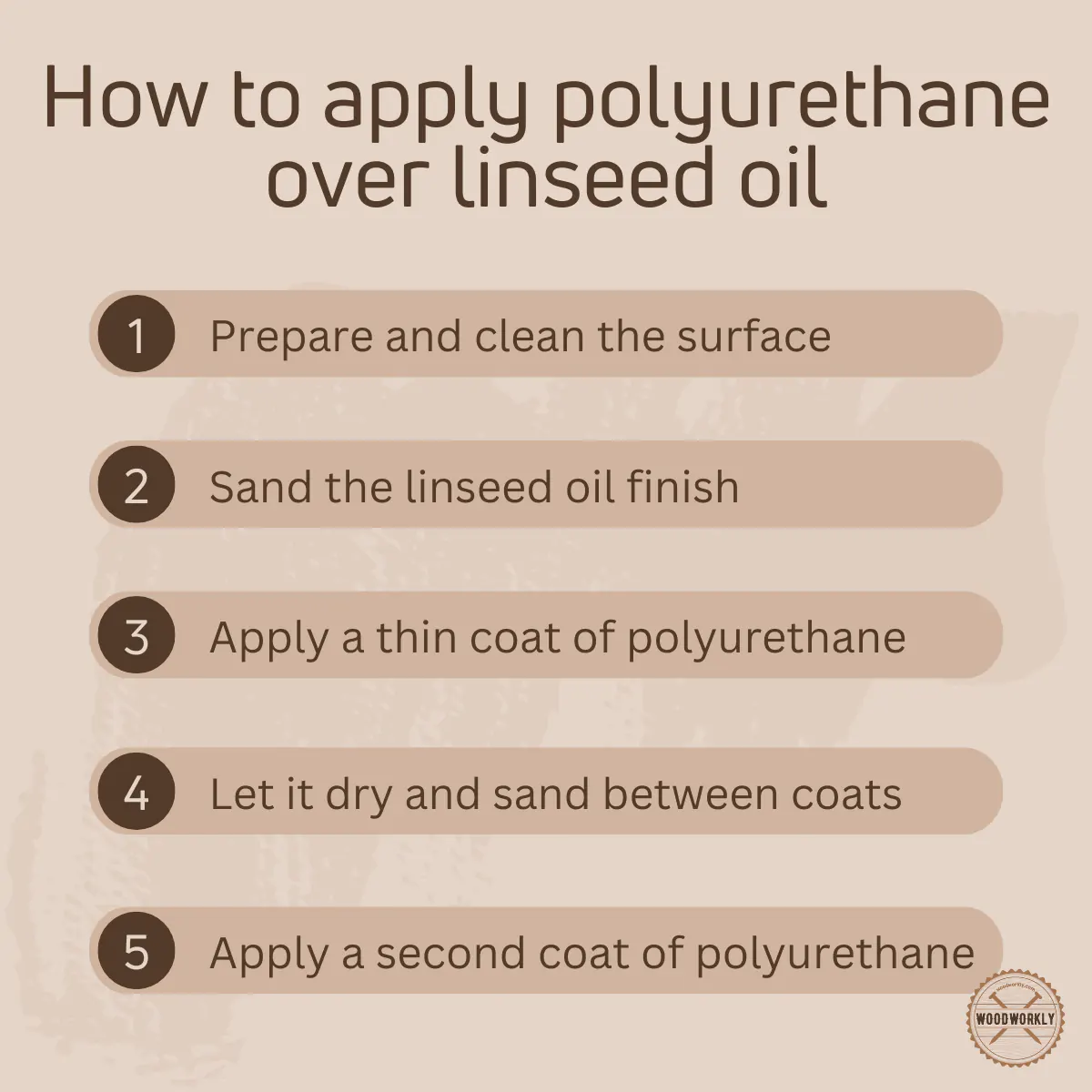
Supplies You’ll Need When Applying Polyurethane Over Linseed Oil
When you apply polyurethane over linseed oil, you will need a specific set of supplies to ensure a successful finish.
So, I will share with you the list of items used when applying polyurethane over linseed oil.
- Linseed Oil
- Polyurethane
- Tack Cloth
- Sandpaper
- Stir Stick
- Container
- Rubber Gloves
- Vacuum cleaner
- Mineral Spirits
- Paintbrush or Applicator
I am confident that having these supplies ready and following proper application techniques will allow you to achieve a professional and durable finish when applying polyurethane over linseed oil.

How To Apply Polyurethane Over Linseed Oil
Did you know that applying polyurethane over linseed oil is a multi-step process?
While doing these processes you need to do careful preparation to get a smooth and durable finish.
Here’re the steps you need to follow when applying polyurethane over linseed oil,
- Make sure the linseed oil is completely cured
- Gather your supplies
- Prepare the workspace
- Sand and clean the surface
- Apply the first coat of polyurethane
- Allow to dry and apply additional coats
- Clean again
Now let’s see how to do this step in detail.
1. Make Sure the Linseed Oil is Completely Cured
Before you apply polyurethane, the first thing to do is to make sure that the linseed oil has completely dried and cured.
I mentioned earlier that this process can take a few weeks to a few months depending on the environmental conditions.
The surface should feel dry to the touch and not leave any residue on your fingers.
2. Gather Your Supplies
I again advise you to prepare all the supplies I mentioned above.
Gather all necessary supplies including linseed oil, polyurethane, sandpaper, tack cloth, paintbrush or applicator, stir stick, container, safety gear, and paper.
3. Prepare the Workspace
Then cover your work area with cloth or plastic sheets to protect against spills and drips.
And don’t forget to work in a place where there is enough ventilation to disperse the smoke.
Also, organize your supplies within easy reach.
4. Sand and Clean the Surface
Here you can sand the wooden surface using sandpaper. This step creates a smooth and receptive surface for the polyurethane.
After sanding, you can use a tack cloth to thoroughly remove dust and debris from this sanded wood surface. This will ensure that you apply the polyurethane to a clean and even surface.
5. Apply the First Coat of Polyurethane
First, stir the polyurethane in the container and dip your paintbrush or paintbrush into the polyurethane and begin applying the first coat.
You can apply a thin, even layer and work along the grain of the wood. Avoid overloading the brush to prevent drips and bubbles.
Applying too much polyurethane over the surface can form blotches and streaks with lots of polyurethane mistakes.
6. Allow to Dry and Apply Additional Coats
Follow the manufacturer’s recommended drying time for the first coat.
After that apply polyurethane additional covers. Most projects benefit from at least two or three for optimal safety and appearance.
Apply a sufficient number of polyurethane coats until you get the result you want when it is drying.
Or you can spray a thin coat of polyurethane over the linseed oil surface after thinning the polyurethane by mixing it with a suitable solvent. (oil-based polyurethane with mineral spirits and water-based polyurethane with water)
7. Clean Again
If you have used oil-based polyurethane, clean your brushes and tools using an appropriate cleaner or solvent.
Then dispose of used clothes and materials properly according to local regulations.
By following these steps, you can successfully apply polyurethane over linseed oil.
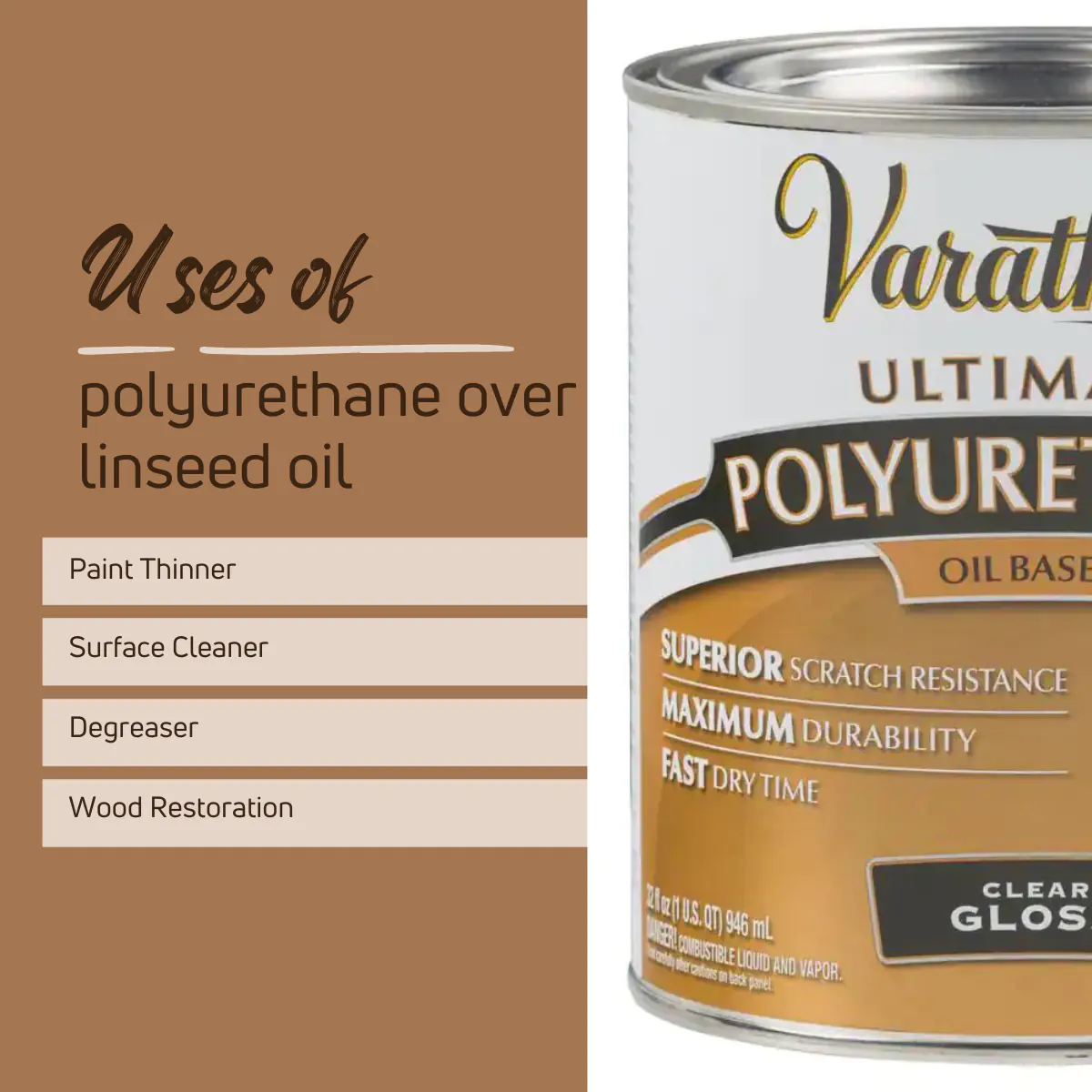
How Long Does Linseed Oil Take to Cure?
It usually takes 24-72 hours for linseed oil to fully cure, but keep in mind that depending on environmental conditions, that time can last from several weeks to several months.
Also, the curing time can vary depending on a variety of factors, including the type of linseed oil you use and the thickness of the layer applied.
Did you know that raw linseed oil heals more slowly than boiled linseed oil due to its natural composition?
During the curing process, linseed oil oxidizes and polymerizes, transforming from a liquid to a solid state.
To ensure that you have fully cured linseed oil, it is essential to be patient and allow enough time for it to dry and harden before applying any additional finish or coating to your woodwork.
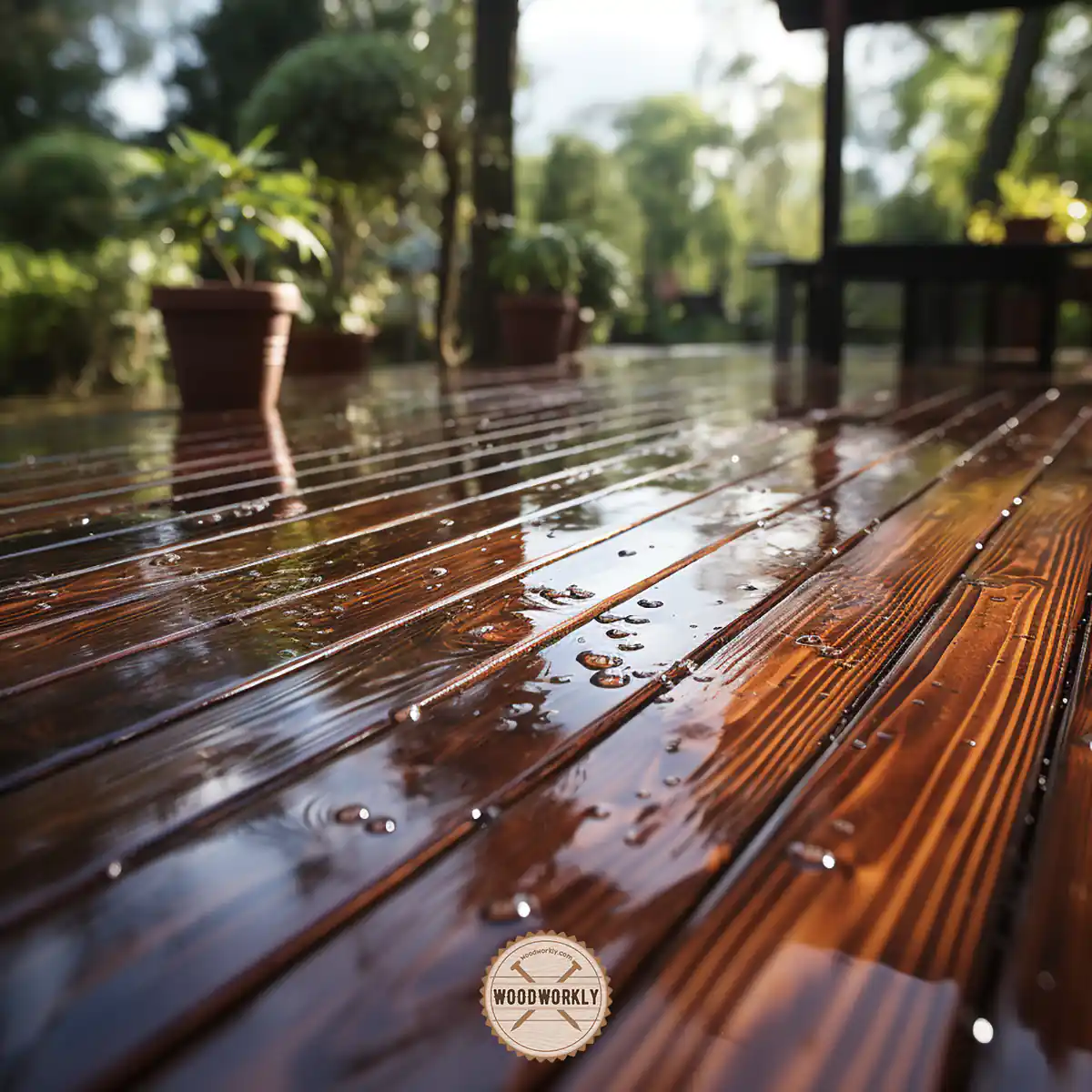
How Long Does Polyurethane Take to Cure?
Polyurethane usually takes 24 to 48 hours to dry and become tack-free, but polyurethane can take up to 30 days to fully and properly cure.
However, the polyurethane curing process continues beyond this initial drying time.
Cure time depends on several factors, including the type of polyurethane (oil-based or water-based), temperature, humidity, and the number of coats applied.
To ensure that the polyurethane fully achieves its desired hardness and protective properties, you can avoid over-handling or exposing the surface to moisture during the curing period.
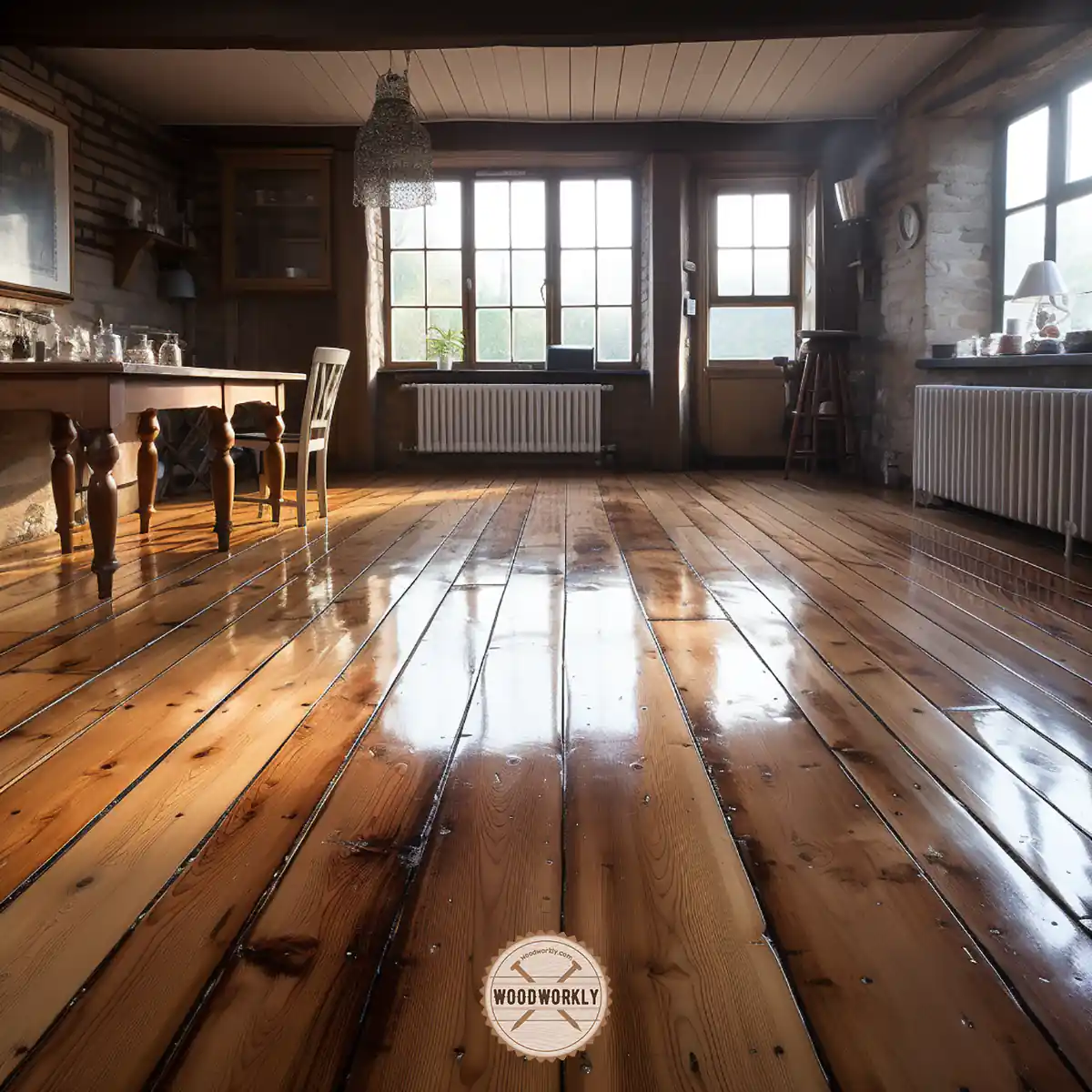
Tips for Applying Polyurethane Over Linseed Oil
I will now share with you some simple tips that I used in the process of applying polyurethane over linseed oil.
- The main thing to remember is to let the linseed oil cure completely before applying the polyurethane.
- Then decide whether you will use oil-based or water-based polyurethane.
Remember; Oil-based polyurethanes generally adhere better to linseed oil, while water-based polyurethanes may require additional surface preparation and compatibility testing. By sanding the wooden surface you can prepare it properly.
- After sanding, one thing you should definitely do is use a tack cloth to remove all dust and debris from the wood surface.
- When applying, be sure to apply polyurethane in thin, even coats. Then you can get this drip-free, bubble-free even finish.
- Choose the appropriate brush or applicator for the type of polyurethane you are using.
- By following the manufacturer’s recommended drying times between coats, you can achieve a long-lasting finish without adhesion problems.
- Polyurethane makes your wood surface water resistant, not waterproof. Therefore, make sure not to let your woodwork or furniture face extreme weather conditions even after applying polyurethane over it.
I am confident that following these tips will ensure the successful application of polyurethane over linseed oil.
What Else Can You Put on Top of Linseed Oil?
Linseed oil is a versatile wood finish that can serve as a base for a variety of other top coats or finishes depending on the result you want.
Listed below are other things I can put on top of the linseed oil I use.
- Shellac – Shellac is a natural resin finish that can be used over linseed oil.
- Lacquers – Nitrocellulose or water-based lacquers can be applied over linseed oil to create a smooth, glossy finish.
- Varnish – Varnish is a durable finish that can be used over linseed oil to provide added protection and a glossy appearance.
- Wax – Furniture wax or paste wax can be applied over linseed oil to add a subtle shine and a smooth, tactile finish.
- Wood Dyes – Wood dyes are another option for adding color to your wood surface while preserving the linseed oil base.
When deciding which finish to use on linseed oil, I advise you to consider factors such as the desired appearance, level of protection, and compatibility between products.
Congrats folks! Now you know exactly how to put polyurethane over linseed oil using the right techniques recommended by professionals.
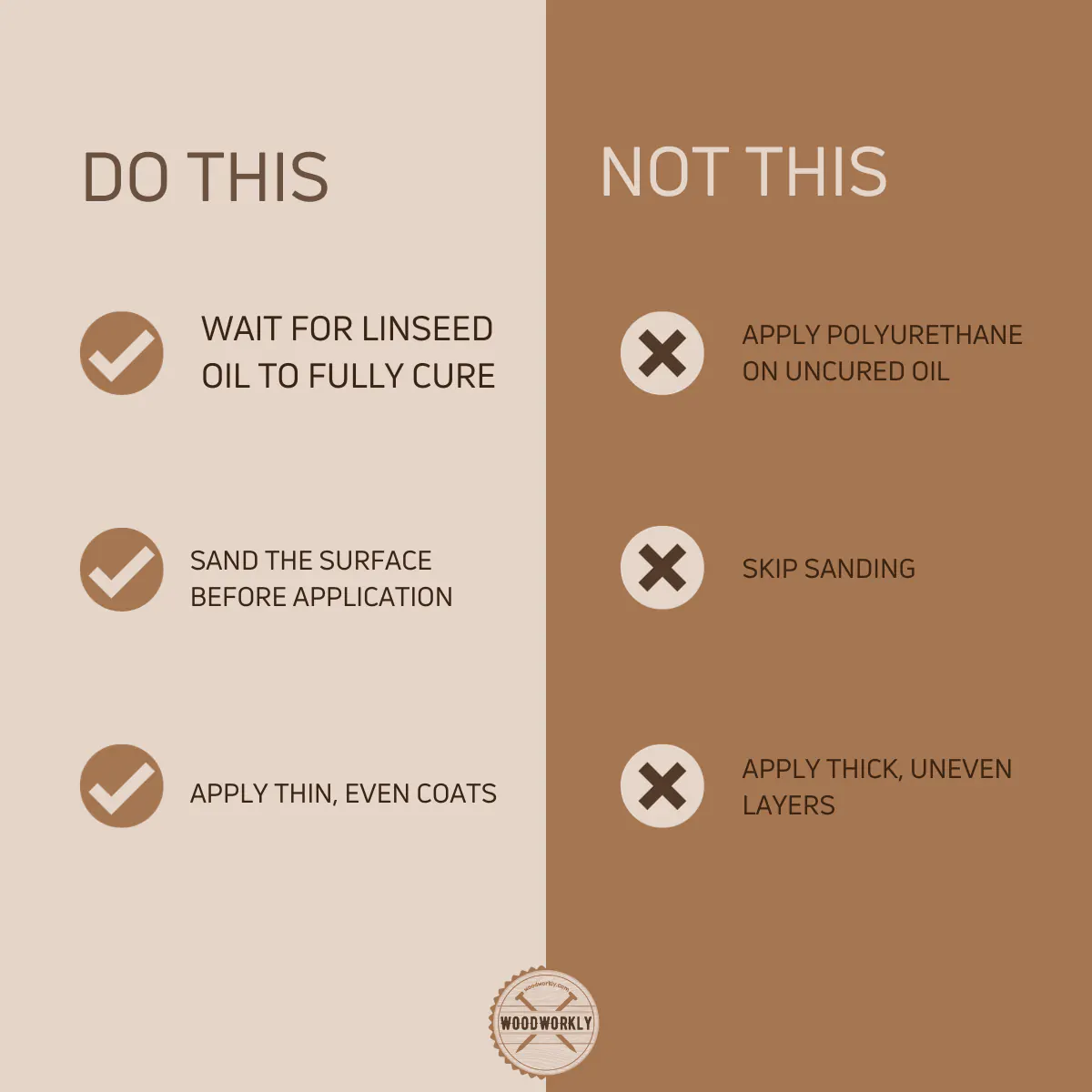
So, let’s answer some frequently asked questions.
FAQs
How Long Should Linseed Oil Dry Before Applying Polyurethane?
Linseed oil should be allowed to dry for at least 24 hours before applying polyurethane to ensure it is fully cured, preventing issues with adhesion or the final finish.
Can Water-Based Polyurethane Be Used Over Linseed Oil?
Yes, water-based polyurethane can be applied over linseed oil, but ensure the oil is dry and consider applying a primer for optimal results.
Does Linseed Oil Need to Be Sanded Before Applying Polyurethane?
Yes, the linseed oil-coated surface should be lightly sanded to remove any imperfections and ensure a smooth, even base for the polyurethane application.
Will Applying Polyurethane Over Linseed Oil Darken the Wood?
Linseed oil can darken the wood over time, and applying polyurethane over it will seal in the color, resulting in a rich, warm tone.
How Many Coats of Polyurethane Should Be Applied Over Linseed Oil?
Typically, two coats of polyurethane are sufficient to provide a durable finish over linseed oil, ensuring the wood is protected and enhanced.
Is It Necessary to Thin Polyurethane Before Applying It Over Linseed Oil?
Thinning polyurethane with mineral spirits (for oil-based) or water (for water-based) can aid in easier application and better adherence when applied over linseed oil.
Can Linseed Oil Be Applied Over Polyurethane?
It’s not advisable to apply linseed oil over polyurethane as it won’t adhere properly; the polyurethane layer should be removed first to apply linseed oil effectively.
What Are the Benefits of Applying Polyurethane Over Linseed Oil?
Applying polyurethane over linseed oil offers enhanced durability, protection from scratches and moisture, and can give the wood a glossy, refined finish.
Is There a Specific Type of Polyurethane That Works Best Over Linseed Oil?
Oil-based polyurethane is generally more compatible with linseed oil due to similar solvents, ensuring a stronger bond and more durable finish.
Did I cover all you wanted to know about: Polyurethane Over Linseed Oil
In this article, I’ve deeply discussed whether can you put polyurethane over linseed oil and how to do that perfectly without making any mistakes.
You can put polyurethane over linseed oil, but in doing this you need to pay attention that the linseed oil is completely dry and cured. Also, it’s important to remember that depending on the environmental conditions, it can take weeks or even months for linseed oil to completely dry.
Furthermore, I’ve answered some frequently asked questions as well.
Hope you’ve learned all you wanted to know about using polyurethane over linseed oil in detail with tips and tricks.
Now it’s time to visit the nearest local store grab the supplies you want and start the project like a pro with all the knowledge you gained from this resource. Happy wood finishing!